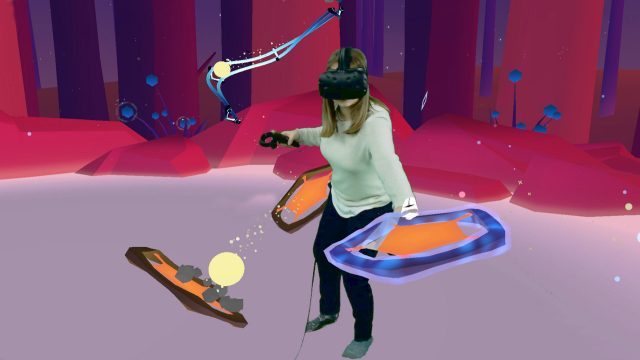Blueprint Reality, developers of VR puzzle game Awaken, have launched the MixCast VR Studio on Steam. Developers can quickly add the free SDK to their Unity-based VR games, which allows users to easily set up, broadcast, or record mixed reality gameplay footage with the help of the utility.
Marketing VR products to the masses is challenging, and more developers are using mixed reality as an effective way of conveying a VR experience to an observer using a conventional screen. By combining live video capture (usually with a green screen for better compositing) with 3D rendering, it is possible to video capture the VR user within the virtual environment, correctly scaled, and interacting convincingly with virtual objects.
Unfortunately, capturing good mixed reality video is not a painless process for developers or users. For best results, the real camera and virtual camera need to achieve perfectly-matched calibration, in terms of position, orientation, scaling and FOV. While there are useful free tools to assist in this process, the setup will still involve plenty of fine adjustment and post processing to composite and synchronise the output. In addition, the VR game ideally should offer mixed reality output options, i.e. with multiple virtual cameras and depth information.

For now, it seems that Unity-based games have the upper hand; SteamVR’s Unity Plugin has supported the externalcamera.cfg file since v1.0.8, allowing developers to more-easily implement a mixed reality mode. Unreal-based games are sometimes demonstrated with mixed reality capture, but this has been achieved with custom solutions, while developers are still waiting for Epic’s integrated mixed reality support.
Blueprint is reaching out to other VR studios in the hope of tidying up this process, offering a free SDK on the Unity Asset Store that, according to their recent developer-focused trailer (heading this article), takes two minutes to apply. Once enabled, subscribers to MixCast VR Studio are guided through a setup process to enable live mixed reality streaming and recording “without any additional work from the user”.
Streamers and other video creators would surely welcome a standard set of mixed reality capture features across games, and Blueprint is leaning on this convenience factor to justify the subscription model for the software. However, the list of supported games is currently unconfirmed (beyond Blueprint’s own Awake), and some developers continue to tread their own path to integrate setup wizards, meaning that mixed reality early adopters are a long way from a homogeneous solution. But with MixCast support planned for Unreal Engine too, perhaps Blueprint can solve the mess of mixed reality setup.
In a comment posted on a recent Awaken Mixed Reality video, Blueprint co-founder Ben Sheftel states “Mixed Reality is in a rapidly evolving stage where technological improvements and advances are happening weekly. We feel that a subscription model is a fair way to enable those continuous improvements to be delivered to developers and broadcasters, rather than static pricing with paid upgrades and a slower release schedule.”






